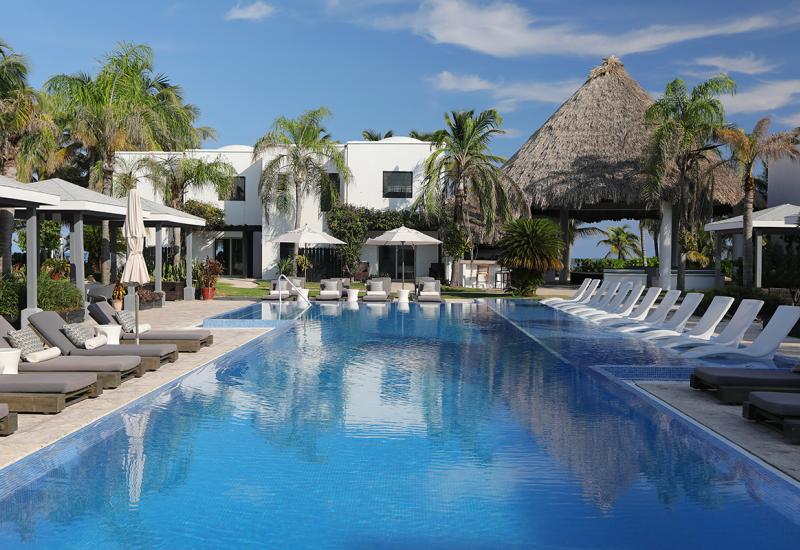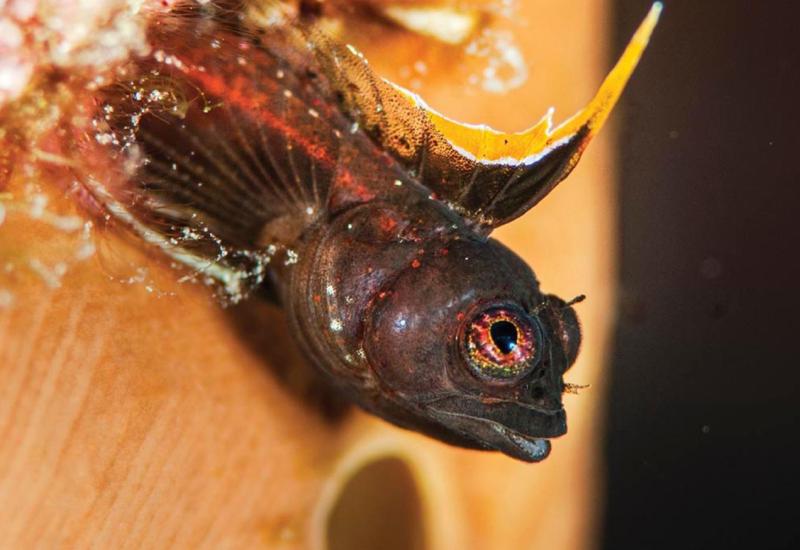Bonaire Travel Guide
||
|---|
|  |
|
A spotted cleaner shrimp clings to a giant anemone.
March 2005
Text and Photography by Kevin Palmer
 |
||
| The descent to the site known as 1,000 Steps (actually just 64) offers enticing views of crystal-clear waters. |
||
|---|
|  |
|
| An orange frogfish.|
The easternmost of the ABC (Aruba, Bonaire and Curaçao) group of islands, Bonaire is located in the extreme southern Caribbean, about 50 miles from the Venezuelan coast. It is situated below the hurricane belt, thus ensuring year-round sunshine and low humidity--and perennially optimal diving conditions. This geographic orientation also explains Bonaire's terrestrial similarities to the American Southwest: namely, a surprisingly rugged landscape replete with donkeys and cactus. Flocks of colorful flamingos outnumber the island's full-time residents, many of whom speak Papiamento, a distinctive creole language that blends Spanish, Portuguese, Dutch and English. As a member of the Netherlands Antilles, Bonaire has long been a tropical escape for the Dutch and other Europeans seeking refuge from chilly weather. The Dutch influence is obvious on any road map--while that of nearby Venezuela can be felt in everything from nightly newscasts to a host of consumer products--but the ambience here is decidedly laid-back Caribbean. Europeans and South Americans are still frequent visitors, but in the last few decades Bonaire's reputation for pristine diving has spread rapidly among American and other international travelers.
Bonaire's miles of irregular coastline are lapped by some of the most beautiful waters in the tropics. The real treasure, though, is the nearly continuous coral reef that in many places begins only yards from shore. This priceless marine asset was recognized decades ago, and in 1979 virtually all of Bonaire's coasts were declared a national marine park, down to a depth of 180 feet. A visitor could easily make five shore dives a day along the leeward coast for two weeks and never repeat a dive. One of the island's best-known shore dives goes by the intimidating name of 1,000 Steps. Fortunately, there are only 64 steps down a cliff face to the water's edge, and any effort is quickly forgotten the moment you see the beauty that's within a few fin-kicks of shore. For all the excellent shore diving, though, there are still plenty of reasons to hop on a dive boat and enlist the aid of eagle-eyed divemasters in finding intriguing creatures, like the elusive frogfish. These masters of disguise are considered a rare sighting in most places, but in Bonaire you might find several on a single dive.
 The ethereal lighting at Salt Pier reveals marine life exploding from every piling. The ethereal lighting at Salt Pier reveals marine life exploding from every piling. |
 |
|||
| The healthy reefs off Klein Bonaire are punctuated by blazing orange elephant-ear sponges. |
 |
| On dive-happy Bonaire, there are said to be more dive shops than restaurants. |
Any attempt to make a list of Bonaire's top dive sites will readily be argued at any dive shop or bar. But most agree that no one should miss a night dive off the Town Pier, for one of the most colorful underwater experiences in the Caribbean. Macro photographers have burned more film and gigabytes of memory here than anywhere else on the island. Another must-dive is the famous wreck of the Hilma Hooker, a 236-foot-long freighter liberally encrusted with brilliant cup corals and sponges. Bonaventure, off the satellite island of Klein Bonaire, features rolling coral gardens, dense schools of fish and colorful resident frogfish. Also not to be forgotten: the unforgettable diving off Salt Pier, which is best done first thing in the morning, when the sun's rays play hypnotically through the pilings. Armadas of tarpon, baitfish and grunts are simply the icing on the cake.
With only a handful of significant roads and a relatively sparse population consisting of friendly locals, oblivious donkeys and the occasional iguana soaking up heat on the pavement, Bonaire begs to be explored. A good 25 percent of the island is occupied by the Washington Slagbaai National Park, where hiking trails, breathtaking vistas and a healthy dose of wildlife can be found. Take a moment to observe the population of flamboyant but shy flamingos, which chose Bonaire as their exclusive breeding site in the southern Caribbean, or to share your lunch with a blue-tailed lizard. Equally unique is one of the Caribbean's last functioning solar salt ponds, on the island's south end. The gleaming mountains of white crystals provide an unusual backdrop for the otherwise flat terrain. One of the great pleasures of this tropical Dutch island is that divers, armed with a good map, can enjoy its many terrestrial pleasures during surface intervals.
 The aquamarine vista from the windward side of Bonaire. The aquamarine vista from the windward side of Bonaire. |
Travel Guide
Dive Conditions: Bonaire's average water temp is 80 degrees.
Town Pier and Salt Pier Diving: To dive either of these sites, divers must be accompanied by a guide, who can obtain the necessary permits and harbormaster's permission.
Weather: Sunny and dry (less than 22 inches of rainfall annually) with temperatures fluctuating between 75 and 85 degrees. Constant 15 mph trade winds keep humidity at bay.
Documents: A passport is necessary for international travel to the island.
Dive Operators: For information on Bonaire dive operators, comprehensive travel guides, special dive deals and recent trip reports submitted by users, click on "TripFinder" at the top of the page.
For More Information: Call the Tourism Corporation Bonaire at (800) BONAIRE or visit www.geographia.com/bonaire. For information on the Bonaire Marine Park, go to www.bmp.org.
|| |---|
| |
A spotted cleaner shrimp clings to a giant anemone.
|
A spotted cleaner shrimp clings to a giant anemone.
March 2005
Text and Photography by Kevin Palmer
|||| |---|---|---|
|| | | The descent to the site known as 1,000 Steps (actually just 64) offers enticing views of crystal-clear waters.| |
| || |---| |
The easternmost of the ABC (Aruba, Bonaire and Curaçao) group of islands, Bonaire is located in the extreme southern Caribbean, about 50 miles from the Venezuelan coast. It is situated below the hurricane belt, thus ensuring year-round sunshine and low humidity--and perennially optimal diving conditions. This geographic orientation also explains Bonaire's terrestrial similarities to the American Southwest: namely, a surprisingly rugged landscape replete with donkeys and cactus. Flocks of colorful flamingos outnumber the island's full-time residents, many of whom speak Papiamento, a distinctive creole language that blends Spanish, Portuguese, Dutch and English. As a member of the Netherlands Antilles, Bonaire has long been a tropical escape for the Dutch and other Europeans seeking refuge from chilly weather. The Dutch influence is obvious on any road map--while that of nearby Venezuela can be felt in everything from nightly newscasts to a host of consumer products--but the ambience here is decidedly laid-back Caribbean. Europeans and South Americans are still frequent visitors, but in the last few decades Bonaire's reputation for pristine diving has spread rapidly among American and other international travelers.
Bonaire's miles of irregular coastline are lapped by some of the most beautiful waters in the tropics. The real treasure, though, is the nearly continuous coral reef that in many places begins only yards from shore. This priceless marine asset was recognized decades ago, and in 1979 virtually all of Bonaire's coasts were declared a national marine park, down to a depth of 180 feet. A visitor could easily make five shore dives a day along the leeward coast for two weeks and never repeat a dive. One of the island's best-known shore dives goes by the intimidating name of 1,000 Steps. Fortunately, there are only 64 steps down a cliff face to the water's edge, and any effort is quickly forgotten the moment you see the beauty that's within a few fin-kicks of shore. For all the excellent shore diving, though, there are still plenty of reasons to hop on a dive boat and enlist the aid of eagle-eyed divemasters in finding intriguing creatures, like the elusive frogfish. These masters of disguise are considered a rare sighting in most places, but in Bonaire you might find several on a single dive.
|| |---|
| The ethereal lighting at Salt Pier reveals marine life exploding from every piling.|
The ethereal lighting at Salt Pier reveals marine life exploding from every piling.|
||||| |---|---|---|---|
|
|
|| |---|
| The aquamarine vista from the windward side of Bonaire.|
The aquamarine vista from the windward side of Bonaire.|
Travel Guide
Dive Conditions: Bonaire's average water temp is 80 degrees.
Town Pier and Salt Pier Diving: To dive either of these sites, divers must be accompanied by a guide, who can obtain the necessary permits and harbormaster's permission.
Weather: Sunny and dry (less than 22 inches of rainfall annually) with temperatures fluctuating between 75 and 85 degrees. Constant 15 mph trade winds keep humidity at bay.
Documents: A passport is necessary for international travel to the island.
Dive Operators: For information on Bonaire dive operators, comprehensive travel guides, special dive deals and recent trip reports submitted by users, click on "TripFinder" at the top of the page.
For More Information: Call the Tourism Corporation Bonaire at (800) BONAIRE or visit www.geographia.com/bonaire. For information on the Bonaire Marine Park, go to www.bmp.org.










